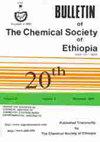New Fe(III), Co(II), Ni(II), Cu(II), and Zn(II) mixed-ligand complexes: stractural, DFT, biological, and molecular docking studies
IF 1.3
4区 化学
Q3 CHEMISTRY, MULTIDISCIPLINARY
引用次数: 0
Abstract
The primary objective of the current framework was to synthesize novel mononuclear 1:1:1 complexes involving FeLG, CoLG, NiLG, CuLG, and ZnLG, where the ligand (L) is identified as 4-[(4-oxo-4,5-dihydro-1,3-thiazol-2-yl)hydrazono]methylphenyl-4-methylbenzenesulfonate, and glycine (G) serves as the co-ligand. Comprehensive characterization of the investigated complexes was achieved through various analytical techniques, including FTIR, UV-Vis spectroscopy, elemental analysis, mass spectra, magnetic susceptibility measurements, molar conductivity assessments, and thermogravimetric analysis (TGA). The determination of stoichiometry was performed employing the molar ratio technique, revealing the octahedral geometry inherent in the isolated metal complexes. Employing a density functional theory (DFT) approach, the molecular structures of the designated compounds were theoretically elevated, and quantum chemical descriptors were derived to provide a deeper insight into their electronic properties. Furthermore, the inhibitory potential of these compounds against fungal strains and pathogenic bacteria prevalent in the Arab environment was evaluated using the disc diffusion method, emphasizing their role in combating diseases affecting humans, animals, and plants. Notably, the metal complexes exhibited superior antibacterial activity, as evidenced by a higher activity index. Molecular docking investigations were conducted to ascertain the inhibitory effects of the compounds on the 1FJ4 protein, with ZnLG emerging as the compound with the highest binding affinity. These results suggest the promising candidacy of these compounds as antimicrobial agents, particularly in the context of combating bacterial and fungal infections. KEY WORDS: Complexes, Antimicrobial, DFT, Schiff base, Molecular docking Bull. Chem. Soc. Ethiop. 2024, 38(2), 397-416. DOI: https://dx.doi.org/10.4314/bcse.v38i2.9新的铁(III)、钴(II)、镍(II)、铜(II)和锌(II)混合配体配合物:结构、DFT、生物学和分子对接研究
当前框架的主要目标是合成涉及 FeLG、CoLG、NiLG、CuLG 和 ZnLG 的新型单核 1:1:1 复合物,其中配体(L)被确定为 4-[(4-氧代-4,5-二氢-1,3-噻唑-2-基)肼基]甲基苯基-4-甲基苯磺酸盐,甘氨酸(G)作为辅助配体。通过各种分析技术,包括傅立叶变换红外光谱、紫外可见光谱、元素分析、质谱、磁感应强度测量、摩尔电导率评估和热重分析(TGA),对所研究的复合物进行了全面的表征。利用摩尔比率技术确定了化学计量,揭示了分离金属复合物固有的八面体几何结构。利用密度泛函理论(DFT)方法,对指定化合物的分子结构进行了理论升华,并得出了量子化学描述符,从而对其电子特性有了更深入的了解。此外,还利用圆盘扩散法评估了这些化合物对阿拉伯环境中流行的真菌菌株和致病细菌的抑制潜力,强调了它们在防治影响人类、动物和植物的疾病方面的作用。值得注意的是,金属复合物表现出了更高的抗菌活性,其活性指数也更高。分子对接研究确定了化合物对 1FJ4 蛋白的抑制作用,其中 ZnLG 成为结合亲和力最高的化合物。这些结果表明,这些化合物有望成为抗菌剂,尤其是在抗击细菌和真菌感染方面。关键词:复合物、抗菌、DFT、席夫碱、分子对接 Bull.Chem.Soc.2024, 38(2), 397-416. DOI: https://dx.doi.org/10.4314/bcse.v38i2.9
本文章由计算机程序翻译,如有差异,请以英文原文为准。
求助全文
约1分钟内获得全文
求助全文
来源期刊
CiteScore
2.20
自引率
8.30%
发文量
113
审稿时长
6-12 weeks
期刊介绍:
The Bulletin of the Chemical Society of Ethiopia (BCSE) is a triannual publication of the Chemical Society of Ethiopia. The BCSE is an open access and peer reviewed journal. The BCSE invites contributions in any field of basic and applied chemistry.

 求助内容:
求助内容: 应助结果提醒方式:
应助结果提醒方式:


